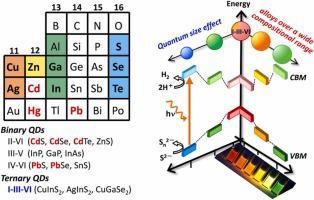Journal of Photochemistry and Photobiology C: Photochemistry Reviews ( IF 13.6 ) Pub Date : 2022-12-16 , DOI: 10.1016/j.jphotochemrev.2022.100569 Tsukasa Torimoto , Tatsuya Kameyama , Taro Uematsu , Susumu Kuwabata

|
I–III–VI multinary semiconductors, which have low toxicity, are attracting much attention as quantum dot (QD) materials for replacing conventional binary semiconductors that contain highly toxic heavy metals, Cd and Pb. Recently, the inherent design flexibility of multinary QDs has also been attracting attention, and optoelectronic property control has been demonstrated in many ways. Besides size control, the electronic and optical properties of multinary QDs can be changed by tuning the chemical composition with various methods including alloying with other semiconductors and deviation from stoichiometry. Due to significant progress in synthetic methods, the quality of such multinary QDs has been improved to a level similar to that of Cd-based binary QDs. Specifically, increased photoluminescence quantum yield and recently narrowed linewidth have led to new application fields for multinary QDs. In this review, a historical overview of the solution-phase synthesis of I–III–VI QDs is provided and the development of strategies for better control of optoelectronic properties, i.e., electronic structures, energy gap, optical absorption profiles, and photoluminescence feature, is discussed. In addition, applications of these QDs to luminescent devices and light energy conversion systems are described. The performance of prepared devices can be improved by controlling the optical properties and electronic structures of QDs by changing their size and composition. Clarification of the unique features of I–III–VI QDs in detail will be the base for further development of novel applications by utilizing the complexity of multinary QDs.
中文翻译:

控制 I-III-VI 半导体量子点的光学性质和电子能量结构以改善其光功能
I-III-VI 多元半导体具有低毒性,作为量子点 (QD) 材料替代含有剧毒重金属 Cd 和 Pb 的传统二元半导体而备受关注。最近,多元量子点固有的设计灵活性也受到关注,光电性能控制也得到了多方面的论证。除了尺寸控制外,多元量子点的电子和光学特性还可以通过各种方法调整化学成分来改变,包括与其他半导体合金化和偏离化学计量。由于合成方法的重大进步,这种多元量子点的质量已经提高到与基于镉的二元量子点相似的水平。具体来说,增加的光致发光量子产率和最近变窄的线宽为多元量子点带来了新的应用领域。在这篇综述中,提供了 I-III-VI 量子点溶液相合成的历史概述,以及更好地控制光电特性的策略的发展,即. 、电子结构、能隙、光吸收曲线和光致发光特征,进行了讨论。此外,还介绍了这些量子点在发光器件和光能转换系统中的应用。通过改变量子点的尺寸和组成来控制量子点的光学性质和电子结构,可以提高制备器件的性能。详细阐明 I-III-VI 量子点的独特特征将成为利用多元量子点的复杂性进一步开发新应用的基础。



























 京公网安备 11010802027423号
京公网安备 11010802027423号